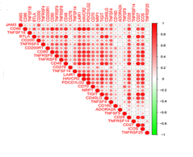JAM3: A prognostic biomarker for bladder cancer via epithelial–mesenchymal transition regulation
DOI:
https://doi.org/10.17305/bb.2024.9979Keywords:
Junctional adhesion molecule 3 (JAM3), bladder cancer (BC), epithelial–mesenchymal transition (EMT), prognostic biomarker, immune cell infiltrationAbstract
Understanding the intricate relationship between prognosis, immune function, and molecular markers in bladder cancer (BC) demands sophisticated analytical methods. To identify novel biomarkers for predicting prognosis and immune function in BC patients, we combined weighted gene co-expression network analysis (WGCNA) and least absolute shrinkage and selection operator (LASSO) regression analysis. This was conducted using data from The Cancer Genome Atlas (TCGA) and Gene Expression Omnibus (GEO) databases. Ultimately, we screened the junctional adhesion molecule 3 (JAM3) as an independent risk factor in BC. High levels of JAM3 were linked to adverse clinical parameters, such as higher T and N stages. Additionally, a JAM3-based nomogram model accurately predicted 1-, 3- and 5-year survival rates of BC patients, indicating potential clinical utility. Functional enrichment analysis revealed that high JAM3 expression activated the calcium signaling pathway, the extracellular matrix (ECM)-receptor interaction, and the PI3K-Akt signaling pathway, and was positively correlated with genes associated with epithelial–mesenchymal transition (EMT). Subsequently, we found that overexpression of JAM3 promoted the migration and invasion abilities in BC cells, regulating the expression levels of N-cadherin, matrix metallopeptidase 2 (MMP2), and Claudin-1 thereby promoting EMT levels. Additionally, we showed that JAM3 was negatively correlated with anti-tumor immune cells such as CD8+ T cells, while positively correlated with pro-tumor immune cells such as M2 macrophages, suggesting its involvement in immune cell infiltration. The immune checkpoint CD200 also showed a positive correlation with JAM3. Our findings revealed that elevated JAM3 levels are predictive of poor prognosis and immune cell infiltration in BC patients by regulating the EMT process.
Citations
Downloads

Downloads
Additional Files
Published
Data Availability Statement
The data generated in this study are publicly available in Gene Expression Omnibus (GEO) at GSE3167, GSE13507, GSE52519, GSE65635, GSE100926 and GSE120736, and in The Cancer Genome Atlas (TCGA) for bladder cancer data.
Issue
Section
Categories
License
Copyright (c) 2024 Zhong-qi Pang, Jian-she Wang, Jin-feng Wang, Ya-xuan Wang, Bo Ji, Yi-dan Xu, Jia-xin He, Lu Zhang, Li-qiu Zhang, Bei-chen Ding, Yang Liu, Ming-hua Ren

This work is licensed under a Creative Commons Attribution 4.0 International License.
How to Cite
Accepted 2024-02-09
Published 2024-02-23









